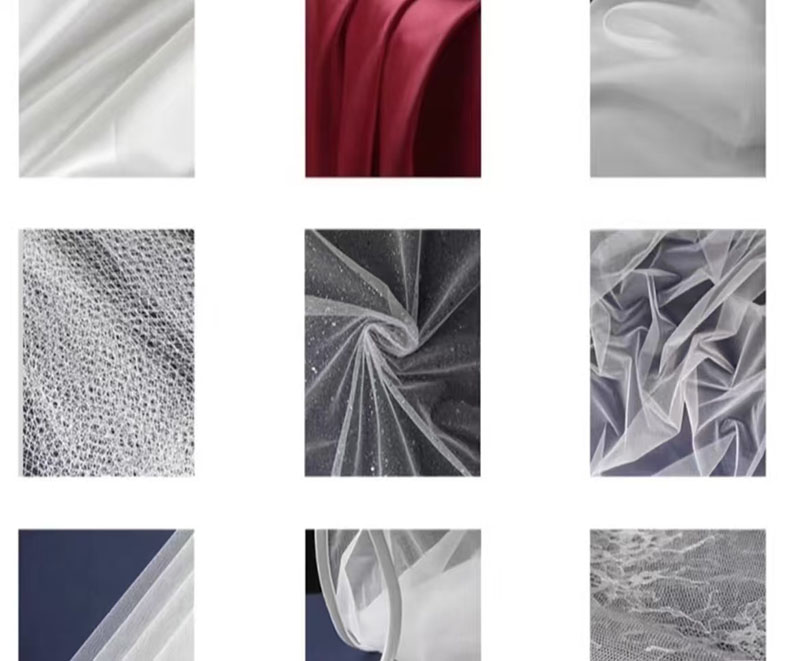
- English
- Español
- Português
- русский
- Français
- 日本語
- Deutsch
- tiếng Việt
- Italiano
- Nederlands
- ภาษาไทย
- Polski
- 한국어
- Svenska
- magyar
- Malay
- বাংলা ভাষার
- Dansk
- Suomi
- हिन्दी
- Pilipino
- Türkçe
- Gaeilge
- العربية
- Indonesia
- Norsk
- تمل
- český
- ελληνικά
- український
- Javanese
- فارسی
- தமிழ்
- తెలుగు
- नेपाली
- Burmese
- български
- ລາວ
- Latine
- Қазақша
- Euskal
- Azərbaycan
- Slovenský jazyk
- Македонски
- Lietuvos
- Eesti Keel
- Română
- Slovenski
- मराठी
- Srpski језик
Different wedding fabrics have a different wearing experience
2025-02-25

Wedding fabric refers to all kinds of materials specially used for making wedding dresses, which show a variety of textures and visual effects through different processes and designs to meet the different needs and aesthetic preferences of brides for wedding dresses.
Different wedding fabrics have their own unique characteristics and performance, such as the elegant luster and soft feel of silk, the light and airy quality of yarn and air permeability, the wrinkle resistance and price concessions of fiber fabrics, the warmth and breadth of wool, the natural freshness and comfort of linen. These characteristics determine the visual effect and wearing experience of the wedding dress.
A detailed introduction of common wedding dress fabrics
1. Silk fabrics are known for their noble and elegant luster and soft touch, suitable for making formal and gorgeous wedding dresses. It has good moisture absorption and breathability and is comfortable to wear. Silk is the most common silk fabric, with natural light color and delicate touch. Rayon is a substitute for silk, imitating the effect of silk, the price is cheap, but the gloss and feel are less.
2. The gauze fabric is light and elegant, with good air permeability and drape feeling, suitable for making romantic and light wedding dress styles. Different density of branch lines will produce different effects, such as fine yarn delicate light, roving is more thick and textured. Organne is often used as a covering layer for wedding dresses, which is light and has a certain hardness and can maintain the shape of the wedding dress. Chiffon is light and transparent, suitable for making a see-through or stacked wedding dress.
3. Fiber fabrics (polyester, nylon) are affordable and have good wrinkle resistance and wear resistance. They can mimic the effect of silk and yarn, but the price is more favorable, suitable for brides on a limited budget. Polyester is wrinkle - and wear-resistant and easy to handle. Nylon has excellent elasticity and strong wear resistance, suitable for making tight wedding dresses and gowns.
There are many types of wedding fabrics, and the above are the three most common fabrics.
Wedding fabric selection and matching
When choosing wedding dress fabric, the following factors should be considered:
You can choose fabrics according to the theme and style of the wedding, such as romantic, gorgeous, simple and so on. Fabrics can be selected according to the season and venue, summer weddings are suitable for light and breathable fabrics, while indoor weddings can choose more gorgeous fabrics.
Not only that, there are also skills in the matching of wedding dress fabrics. Different fabrics are suitable for different wedding design, the gloss and texture of the fabric also affect the color of the presentation effect, to choose the appropriate fabric and color collocation, in order to show the best visual effect.
Dress fabric cleaning and maintenance
It is recommended to send the wedding dress to a professional wedding cleaning shop for processing to ensure the cleaning effect and the integrity of the wedding dress. If you need to wash at home, follow fabric cleaning instructions, use a mild detergent, and avoid bleach and strong detergents.
After cleaning the wedding dress should be hung in a cool ventilated place to dry, avoid direct sunlight and high temperature baking. When stored, it should also be suspended to avoid deformation caused by folding or heavy pressure.
Storage should be kept dry and ventilated to avoid moisture and moth. Can be protected with desiccant and insect repellent. Check fabrics and decorations regularly, and repair them in time if they are loose or damaged.
The new development trend of wedding fabric
With the development of science and technology, more and more innovative materials are applied in wedding dress production, such as 3D printed fabrics, smart fabrics and so on. These new materials not only have a unique visual effect and texture, but also meet the personalized needs of brides for wedding dresses.
Environmental protection has become an important issue in today's society, and more and more wedding designers have begun to pay attention to the environmental protection of fabrics. They choose to use renewable materials or recycled materials to make wedding dresses to reduce pollution and damage to the environment. At the same time, they also advocate brides to choose environmentally friendly wedding fabrics and cleaning and maintenance methods, and jointly contribute to the earth's environment.


